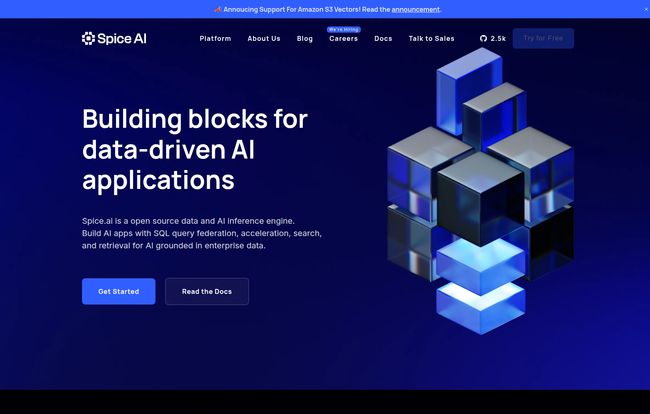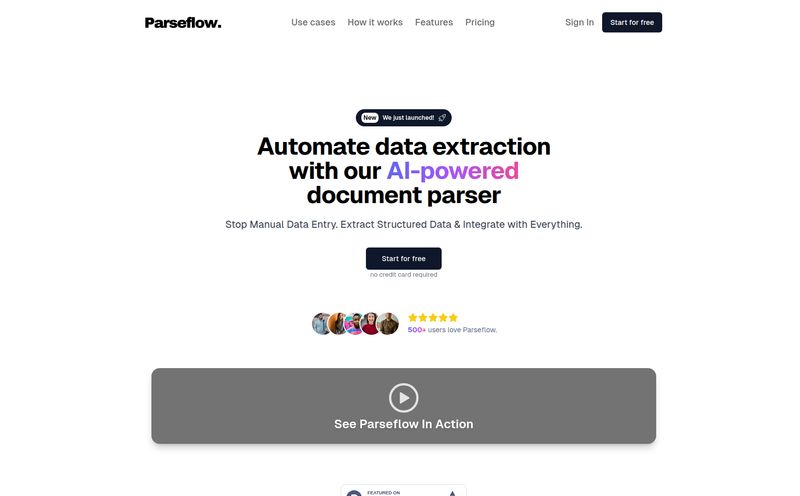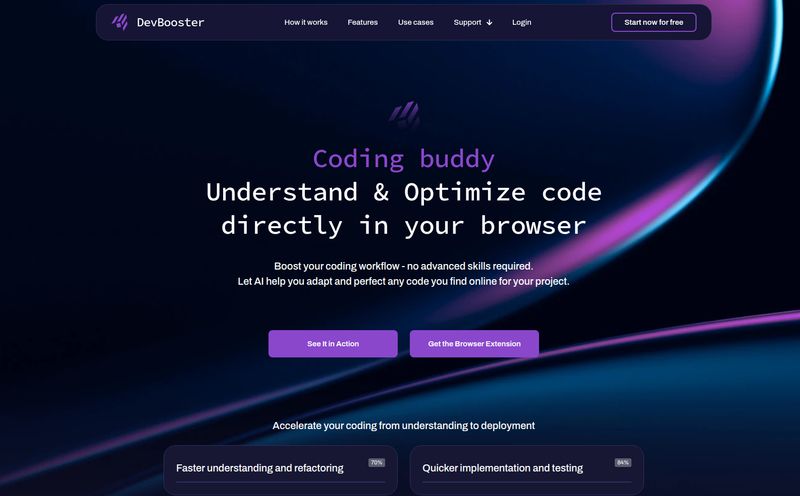If you've ever been deep in the trenches of building an app that needs to be smart—I mean, truly intelligent, using real-time data and maybe an AI model or two—you know the pain. It's the plumbing. The absolute soul-crushing nightmare of getting data from Point A (your production database), Point B (a third-party API), and Point C (some obscure data lake) to all play nice together. You spend 80% of your time on this data janitor work and 20% on the cool, innovative feature you actually wanted to build. It’s a story as old as software development itself.
So when a tool comes along that claims to fix this, my inner skeptic, honed by years of chasing shiny new frameworks, sits up and pays attention. The tool in question today is Spice AI. The name's catchy, I'll give it that. But does it actually bring the heat, or is it just another flash in the pan? I've been digging into it, and honestly, there's a lot to talk about.
So, What Exactly Is Spice AI, Anyway?
Let's cut through the marketing jargon. At its heart, Spice AI is an open-source data and AI inference engine. Think of it less as a single tool and more like a set of high-powered LEGO bricks for developers building intelligent software. It’s designed to be the middle layer—the connective tissue—that lives between all your scattered data sources and the application you're trying to build.
Its big promise is to give you ready-to-use infrastructure for accessing, accelerating, searching, and running AI models, with a special focus on Web3 data. Instead of building your own complex data pipelines from scratch (a process that can take months and a whole lot of hair-pulling), Spice AI wants to hand you the pre-fabricated parts. It’s an ambitious goal. Almost too ambitious, if you ask me. But the idea of querying data from a dozen places as if it were one simple database... well, that’s the dream isn't it?

Visit Spice AI
The Core Ingredients: What's Under the Hood?
So what are these LEGO bricks made of? From what I've seen, Spice AI's power comes from a few core capabilities that address some very specific, very real developer headaches.
SQL Federation: Your One Query to Rule Them All
This is the big one for me. Spice AI offers SQL query federation. In plain English, this means you can write a single SQL query to pull data from multiple, completely different sources simultaneously. Imagine having your user data in a Postgres database, real-time market data coming from a Kafka stream, and historical logs sitting in an S3 bucket. Normally, getting a holistic view would require writing separate clients for each, fetching the data, and then trying to stitch it all together in your application code. It's messy and brittle.
With federation, you just point Spice AI at your sources, and then you can write a query like SELECT FROM postgres_users JOIN kafka_stream ON.... It’s a massive simplification. It turns the chaotic mess of modern data architecture into something that feels, well, sane. I remember one project where we spent two full sprints just trying to get our main DB to talk nicely with an external API. This would have been a lifesaver.
Blazing-Fast Data Acceleration
Querying is one thing, but making it fast is another. Spice AI puts a huge emphasis on data acceleration. It does this by creating high-performance, materialized caches of your data, powered by technologies like Apache Arrow. The best analogy I can think of is this: instead of driving to a library across the country every time you need a fact (i.e., hitting your primary database or a slow API), Spice AI builds a super-fast, local branch of that library right next door with all the books you read most often. Your queries hit this local cache, and the result is incredibly low latency. For front-end dashboards, real-time analytics, and especially AI inferrencing, this speed is not a nice-to-have; it's a requirement.
From Model to Production: AI Serving Made Easy
Okay, so you've trained your fancy AI model. Now what? Getting it into a production application where it can actually make predictions on live data is a whole other mountain to climb. Spice AI aims to simplify this by integrating model deployment and serving directly into its platform. You can deploy your models and have them run directly against the accelerated data streams it manages. This closes the loop, creating a more unified environment where your data and your AI models live together, which can seriously cut down on complexity and latency.
Why Developers Might Actually Love This
The whole platform feels very developer-first. It's open-source, which immediately earns it some trust points in my book. You're not locked into a proprietary black box. You can see the code, contribute to it, and understand how it works. I love that.
The composable architecture is also a smart move. You don’t have to adopt the entire Spice AI ecosystem. If you just need the data acceleration and caching, you can use just that piece. If you only care about the SQL federation, you can start there. This allows for incremental adoption, which is much more palatable for existing projects than a full “rip and replace” approach. They seem to understand that we dont always have the luxury of starting from a green field.
Let's Be Real: The Not-So-Spicy Parts
Of course, it’s not all perfect. No tool is. Based on the architecture, there are a few things to keep in mind. First, while it simplifies a lot, there’s still an initial setup and configuration. You have to connect it to your data sources, define your data pods, and get things flowing. It’s not magic. For teams without a solid grasp of their own data architecture, this could still be a hurdle.
Second, there’s an inherent learning curve. If you’re not comfortable with SQL or the basic concepts of data pipelines and AI, you'll have some homework to do. This isn't a no-code platform for beginners; it's a power tool for developers who know what they're doing but want to do it faster. And finally, its performance is obviously tied to the performance of the external data sources it relies on. It can cache things to make them faster, but it can’t make a fundamentally broken API magically work perfectly.
The Classic Dilemma: Build vs. Buy (or, Use Spice Cloud)
Every engineering lead has stared at this crossroads. Do we spend the next quarter (or two) and a huge chunk of our budget building our own custom data infrastructure, or do we use a managed service? Spice AI presents this choice very clearly with their comparison of building it yourself versus using their Spice Cloud platform. I've put their numbers into a little table because it really drives the point home.
| Feature | The Spice Cloud | Building & Operating Yourself |
|---|---|---|
| Data & Caching Cost | Included | $65k to $100k+ |
| Infrastructure Cost | Included in Spice Cloud | $15k to $25k+ |
| Data and Infrastructure Engineers | Managed by Spice AI | $15k to $25k |
| Time to Implement | Minutes | Typically 3 to 6 months |
| SOC2 / Enterprise SLAs | Included in Enterprise Plan | Self-managed 24/7 on-call |
Looking at that, the value proposition is pretty stark. For a startup or even a mid-sized company, saving 3-6 months of development time is huge. That’s time you can spend on building features that your customers actually pay for. The cost savings are just the cherry on top.
Breaking Down the Price Tag
So how much does this magic cost? The pricing structure seems to have a few tiers, aimed at different scales of use.
- Managed Spice.ai Open Source: This seems to be for teams that want the power of the open-source core for high-performance caching but don’t want the hassle of managing the infrastructure themselves. They list this in the $1k to $5k per month range. Not cheap, but for a business-critical function, it's likely less than the cost of an engineer to manage it.
- The Spice Cloud Platform: This is the main managed offering. It's great to see a "Start for Free" option here. This lets you get in, connect a data source, and see if it works for you without pulling out a credit card. It’s built on a multi-cloud, SOC2-compliant foundation, which is table stakes for any serious B2B platform these days.
- The Spice Cloud Platform Enterprise: This is the classic "Contact for Pricing" tier. You know the drill. This is for large organizations that need the highest levels of availability, dedicated support, and strict compliance guarantees.
My take? The free tier is essential for developer adoption. The pricing clearly positions this as a professional tool for businesses, not a hobbyist toy, and that makes perfect sense.
Final Thoughts: Is This a Must-Have Ingredient?
After digging in, I'm genuinely optimistic about Spice AI. It's tackling a problem that is real, painful, and widespread. The developer-first, open-source, and composable approach is exactly what the modern software world needs. It's not a magic wand that will solve all your data problems, but it does seem to be a massive accelerator.
If you're a developer or a team constantly bogged down by data plumbing, especially in the Web3 or real-time AI space, you should absolutely be looking at this. The ability to unify disparate data sources with SQL and accelerate them for low-latency access could fundamentally change your development speed. For those just starting out or working on simpler projects, it might be overkill. But for anyone building the next generation of intelligent, data-driven applications, Spice AI might just be the secret ingredient you've been looking for.
Frequently Asked Questions
What is Spice AI in simple terms?
Think of it as a universal adapter and accelerator for your data. It lets you plug all your different data sources (databases, APIs, etc.) into one place and then query them all together super fast using standard SQL. It's designed to save developers time on data infrastructure.
Is Spice AI only for Web3?
While it has a strong focus and pre-loaded datasets for Web3 (like Ethereum, Bitcoin data), its core technology is data-agnostic. You can use it to connect and accelerate data from traditional Web2 sources like Postgres, S3, Dremio, and various APIs just as easily.
Do I need to be an expert in SQL to use Spice AI?
A working knowledge of SQL is definitely beneficial, as it's the primary way you'll interact with your federated data. However, the goal of the platform is to simplify the infrastructure side, so you can focus on writing the queries rather than building the connections.
Is Spice AI really free to use?
The core Spice AI engine is open-source, so you can download and run it yourself for free. Their managed cloud offering, the Spice Cloud Platform, has a free starter tier that lets you try out the service with certain limitations before committing to a paid plan.
What's the main benefit of using Spice AI over building my own data pipeline?
The biggest benefit is speed—both in query performance and, more importantly, in development time. Building a robust, scalable, and fast data pipeline from scratch can take a team of engineers months. Spice AI aims to provide that infrastructure out-of-the-box, letting you get to market faster.
How does Spice AI help with AI model deployment?
It provides an integrated environment to serve AI models directly against the accelerated data it manages. This reduces the latency and complexity of getting live data to your model for real-time predictions, closing the gap between data preparation and AI inference.



